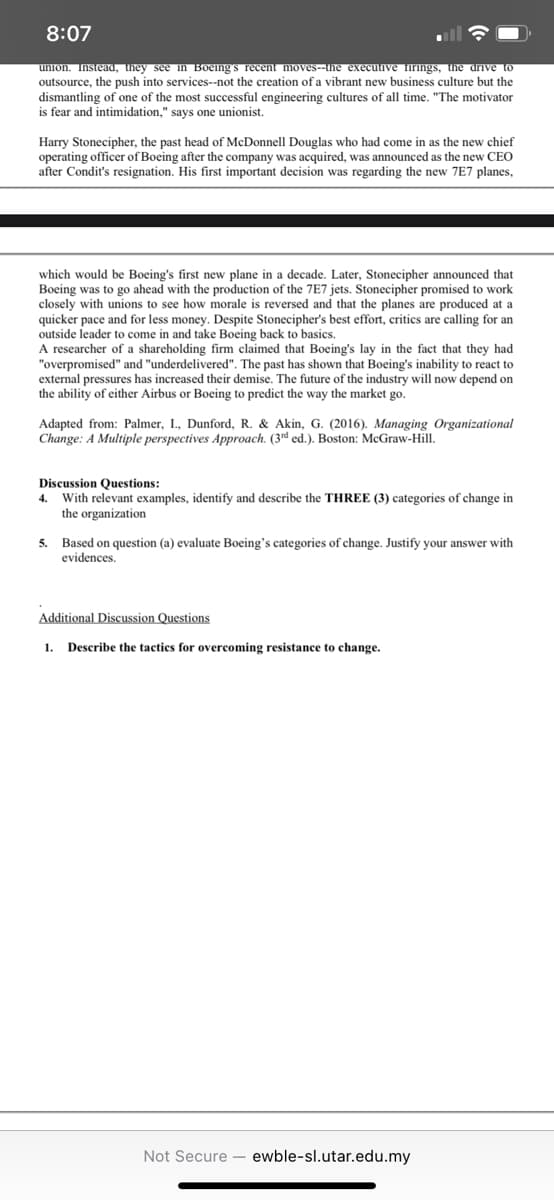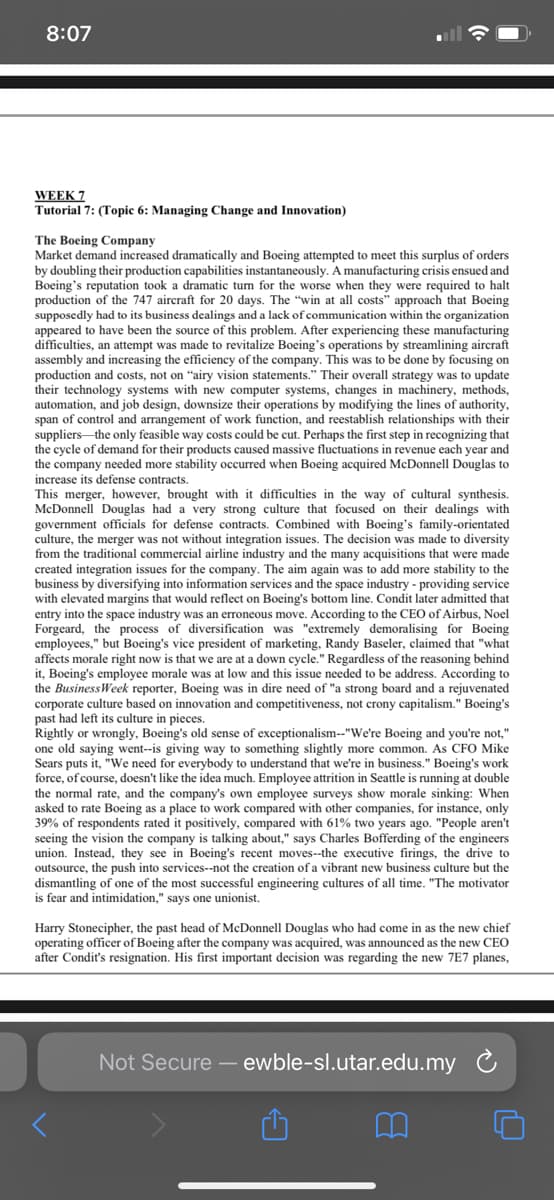Additional Discussion Questions 1. Describe the tacties for overcoming resistance to change.
Additional Discussion Questions 1. Describe the tacties for overcoming resistance to change.
Chapter1: Taking Risks And Making Profits Within The Dynamic Business Environment
Section: Chapter Questions
Problem 1CE
Related questions
Question
Please answer for me the additional discussion question, question 1

Transcribed Image Text:8:07
union. Instead, they see in Boeing's recent moves--the executive firings, the drive to
outsource, the push into services--not the creation of a vibrant new business culture but the
dismantling of one of the most successful engineering cultures of all time. "The motivator
is fear and intimidation," says one unionist.
Harry Stonecipher, the past head of McDonnell Douglas who had come in as the new chief
operating officer of Boeing after the company was acquired, was announced as the new CEO
after Condit's resignation. His first important decision was regarding the new 7E7 planes,
which would be Boeing's first new plane in a decade. Later, Stonecipher announced that
Boeing was to go ahead with the production of the 7E7 jets. Stonecipher promised to work
closely with unions to see how morale is reversed and that the planes are produced at a
quicker pace and for less money. Despite Stonecipher's best effort, critics are calling for an
outside leader to come in and take Boeing back to basics.
A researcher of a shareholding firm claimed that Boeing's lay in the fact that they had
"overpromised" and "underdelivered". The past has shown that Boeing's inability to react to
external pressures has increased their demise. The future of the industry will now depend on
the ability of either Airbus or Boeing to predict the way the market go.
Adapted from: Palmer, I., Dunford, R. & Akin, G. (2016). Managing Organizational
Change: A Multiple perspectives Approach. (3rd ed.). Boston: McGraw-Hill.
Discussion Questions:
With relevant examples, identify and describe the THREE (3) categories of change in
the organization
4.
5.
Based on question (a) evaluate Boeing's categories of change. Justify your answer with
evidences.
Additional Discussion Questions
1. Describe the tactics for overcoming resistance to change.
Not Secure - ewble-sl.utar.edu.my

Transcribed Image Text:8:07
WEEK 7
Tutorial 7: (Topic 6: Managing Change and Innovation)
The Boeing Company
Market demand increased dramatically and Boeing attempted to meet this surplus of orders
by doubling their production capabilities instantaneously. A manufacturing crisis ensued and
Boeing's reputation took a dramatic tum for the worse when they were required to halt
production of the 747 aircraft for 20 days. The "win at all costs" approach that Boeing
supposedly had to its business dealings and a lack of communication within the organization
appeared to have been the source of this problem. After experiencing these manufacturing
difficulties, an attempt was made to revitalize Boeing's operations by streamlining aircraft
assembly and increasing the efficiency of the company. This was to be done by focusing on
production and costs, not on "airy vision statements." Their overall strategy was to update
their technology systems with new computer systems, changes in machinery, methods,
automation, and job design, downsize their operations by modifying the lines of authority,
span of control and arrangement of work function, and reestablish relationships with their
suppliersthe only feasible way costs could be cut. Perhaps the first step in recognizing that
the cycle of demand for their products caused massive fluctuations in revenue each year and
the company needed more stability occurred when Boeing acquired McDonnell Douglas to
increase its defense contracts.
This merger, however, brought with it difficulties in the way of cultural synthesis.
McDonnell Douglas had a very strong culture that focused on their dealings with
government officials for defense contracts. Combined with Boeing's family-orientated
culture, the merger was not without integration issues. The decision was made to diversity
from the traditional commercial airline industry and the many acquisitions that were made
created integration issues for the company. The aim again was to add more stability to the
business by diversifying into information services and the space industry - providing service
with elevated margins that would reflect on Boeing's bottom line. Condit later admitted that
entry into the space industry was an erroneous move. According to the CEO of Airbus, Noel
Forgeard, the process of diversification was "extremely demoralising for Boeing
employees," but Boeing's vice president of marketing, Randy Baseler, claimed that "what
affects morale right now is that we are at a down cycle." Regardless of the reasoning behind
it, Boeing's employee morale was at low and this issue needed to be address. According to
the BusinessWeek reporter, Boeing was in dire need of "a strong board and a rejuvenated
corporate culture based on innovation and competitiveness, not crony capitalism." Boeing's
past had left its culture in pieces.
Rightly or wrongly, Boeing's old sense of exceptionalism--"We're Boeing and you're not,"
one old saying went--is giving way to something slightly more common. As CFO Mike
Sears puts it, "We need for everybody to understand that we're in business." Boeing's work
force, of course, doesn't like the idea much. Employee attrition in Seattle is running at double
the normal rate, and the company's own employee surveys show morale sinking: When
asked to rate Boeing as a place to work compared with other companies, for instance, only
39% of respondents rated it positively, compared with 61% two years ago. "People aren't
seeing the vision the company is talking about," says Charles Bofferding of the engineers
union. Instead, they see in Boeing's recent moves--the executive firings, the drive to
outsource, the push into services--not the creation of a vibrant new business culture but the
dismantling of one of the most successful engineering cultures of all time. "The motivator
is fear and intimidation," says one unionist.
Harry Stonecipher, the past head of McDonnell Douglas who had come in as the new chief
operating officer of Boeing after the company was acquired, was announced as the new CEO
after Condit's resignation. His first important decision was regarding the new 7E7 planes,
Not Secure – ewble-sl.utar.edu.my C
Expert Solution
This question has been solved!
Explore an expertly crafted, step-by-step solution for a thorough understanding of key concepts.
Step by step
Solved in 2 steps

Recommended textbooks for you

Understanding Business
Management
ISBN:
9781259929434
Author:
William Nickels
Publisher:
McGraw-Hill Education

Management (14th Edition)
Management
ISBN:
9780134527604
Author:
Stephen P. Robbins, Mary A. Coulter
Publisher:
PEARSON

Spreadsheet Modeling & Decision Analysis: A Pract…
Management
ISBN:
9781305947412
Author:
Cliff Ragsdale
Publisher:
Cengage Learning

Understanding Business
Management
ISBN:
9781259929434
Author:
William Nickels
Publisher:
McGraw-Hill Education

Management (14th Edition)
Management
ISBN:
9780134527604
Author:
Stephen P. Robbins, Mary A. Coulter
Publisher:
PEARSON

Spreadsheet Modeling & Decision Analysis: A Pract…
Management
ISBN:
9781305947412
Author:
Cliff Ragsdale
Publisher:
Cengage Learning

Management Information Systems: Managing The Digi…
Management
ISBN:
9780135191798
Author:
Kenneth C. Laudon, Jane P. Laudon
Publisher:
PEARSON

Business Essentials (12th Edition) (What's New in…
Management
ISBN:
9780134728391
Author:
Ronald J. Ebert, Ricky W. Griffin
Publisher:
PEARSON

Fundamentals of Management (10th Edition)
Management
ISBN:
9780134237473
Author:
Stephen P. Robbins, Mary A. Coulter, David A. De Cenzo
Publisher:
PEARSON